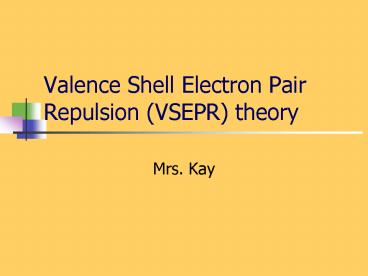Valence Shell Electron Pair Repulsion VSEPR theory - PowerPoint PPT Presentation
1 / 17
Title:
Valence Shell Electron Pair Repulsion VSEPR theory
Description:
More than one set of bonding pairs of electrons may bind any two atoms together ... Trigonal Bipyramidal. Molecules shaped by five electron pairs ... – PowerPoint PPT presentation
Number of Views:3557
Avg rating:3.0/5.0
Title: Valence Shell Electron Pair Repulsion VSEPR theory
1
Valence Shell Electron Pair Repulsion (VSEPR)
theory
- Mrs. Kay
2
Assumptions for VSEPR
- Atoms in a molecule are bound together by
electron pairs. These are called bonding pairs.
More than one set of bonding pairs of electrons
may bind any two atoms together (multiple
bonding). - 1 pair single bond
- 2 pair double bond
- 3 pair triple bond
3
- Some atoms in a molecule may also possess pairs
of electrons not involved in bonding. These are
called lone pairs or non-bonded pairs.
4
- The bonding pairs and lone pairs around any
particular atom in a molecule adopt positions in
which their mutual interactions are minimized. - Electron pairs are negatively charged and will
get as far apart from each other as possible.
5
Bonding angles
- Lone pairs occupy more space than bonding
electron pairs. - Double bonds occupy more space than single bonds.
- LP-LP gt LP-BP gt BP-BP
- Lone pairs spread out more than bonding pairs,
therefore lone pairs have less repulsions than
bonding pairs
6
Where to start?
- Draw the Lewis structure based upon the atom of
interest. Ex CO2 - Determine the central atom (pick the least
electronegative atom) Ex C
7
- Determine the number bonding pairs Ex 2
- Determine the number of lone pairs or non-bonding
pairs. Ex 0 - sets bonding pairs (single, double, or triple)
8
5. Using the chart figure out the shape.
9
Put to memory!!
- The predicted geometry of the molecule is based
on the number of
10
(No Transcript)
11
Make your table
- As a group we will organize a table that will
help you decide molecular shapes.
12
Practice
- Use VSEPR to predict the following shape
- SO2
- SO3
- SO4 -2
- AsCl3
- SI2
- CH3F
- CH2F2
- NH4
- NO2-
- NO2
- H3O
13
Advanced chemistry ONLY
- You are responsible for 2 extra shapes
- Triagonal bipyramidal 5 electron pairs
- Octahedral 6 electron pairs
14
Trigonal Bipyramidal
- Molecules shaped by five electron pairs
- ExamplePCl5 phosphorous pentachloride
15
- Elements in row 3,4,... have access to d orbitals
(unlike row 2 elements that have only s and p
orbitals) and can therefore have more than 8
electrons around them in certain compounds. - Recall that P has a normal valence of 3 with one
lone pair. - If that lone pair is divided into two extra
unpaired electrons to be used in creating bonds,
we then have a hypervalence of 5.
16
Octahedral
- Six bonding sets
- Examplehexafluorophosphide PF6-
17
On the computer
- Exercise to practice on calculator
- http//www.shef.ac.uk/chemistry/vsepr/jmol/exercis
es.html

